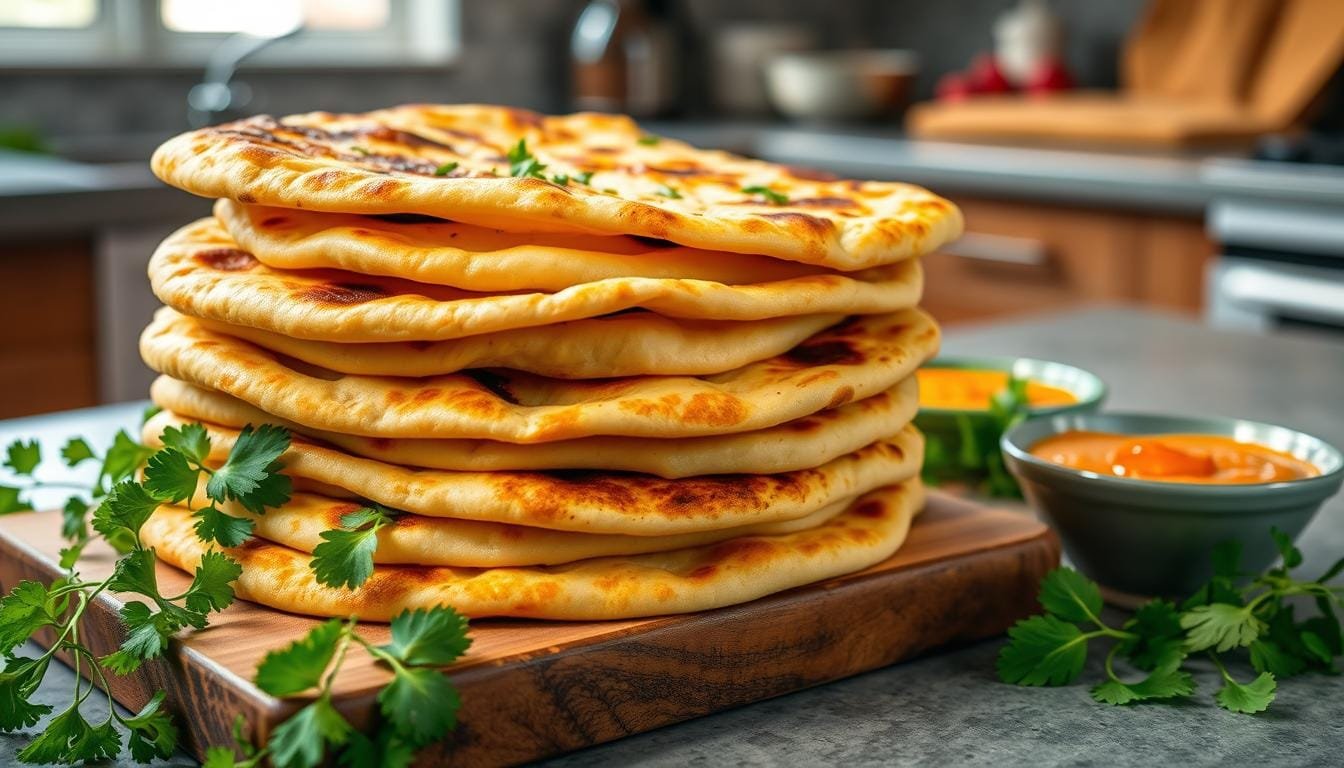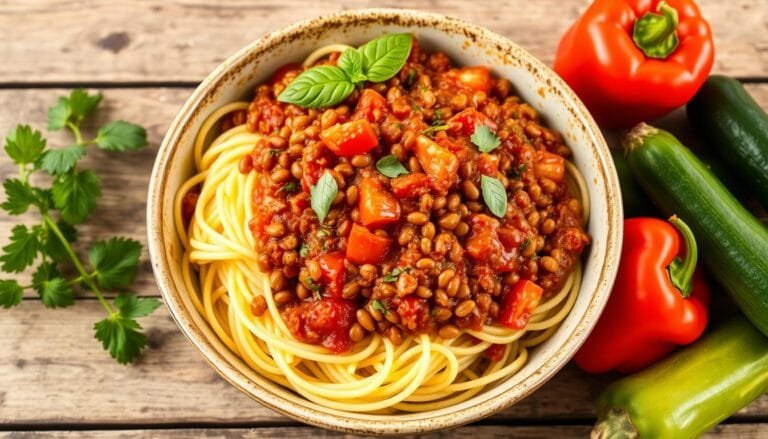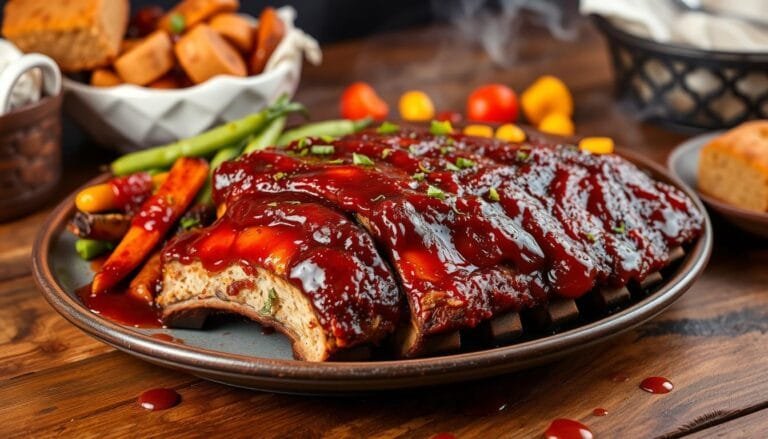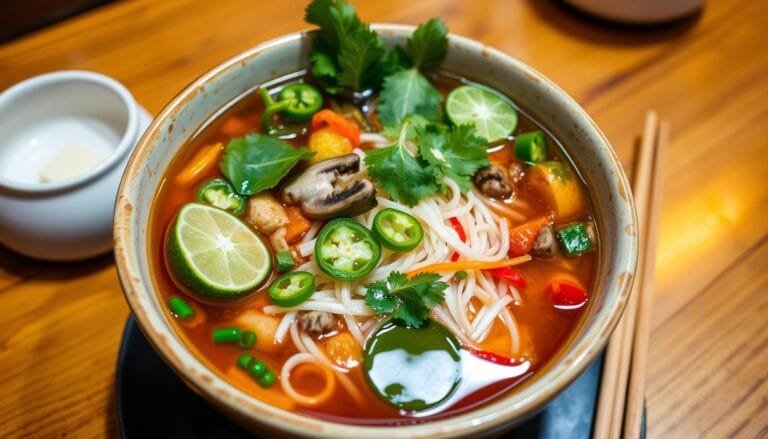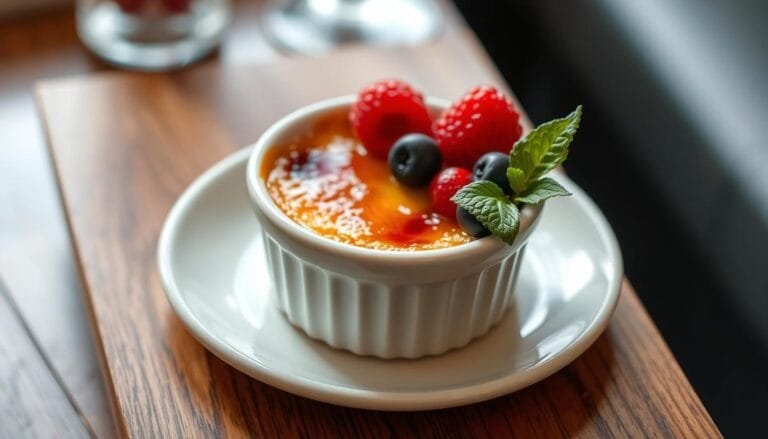As a vegan foodie, I love the rich flavors and comforting textures of Indian cuisine. Naan bread is a favorite of mine, perfect with curries and tikka masala. But traditional naan often has dairy, making it hard for those on a plant-based diet. That’s why I’m excited to share my simple recipe for vegan naan.
After over a dozen recipe tests, I’ve got a vegan naan that’s just as good as the original. It uses just 8 basic ingredients, including flour, yeast, and warm water. This homemade flatbread is quick and easy to make. It’s a soft, dairy-free bread that’s great for scooping up Indian cuisine flavors.
The Art of Traditional Indian Flatbread
Naan, the iconic Indian bread, shows the rich culinary tradition of the subcontinent. It has a soft, pillowy texture and pairs well with many dishes.
History of Naan in Indian Cuisine
The origins of naan go back to ancient times. It was baked in hot clay ovens called tandoors. The dough included yogurt, giving it a unique tang and softness.
Over time, naan has changed, with different regions creating their own versions. Each shows the diverse Indian bread traditions.
Why Naan is a Staple in Indian Meals
Naan’s versatility makes it a key part of the Indian culinary tradition. It’s great for scooping up curries, dipping in dals, or enjoying alone. Its ability to soak up flavors and offer a satisfying texture has made it a favorite.
“Naan is not just a bread; it’s a cultural icon that has transcended borders and become a global sensation.”
The charm of naan continues to attract people worldwide. It goes from the traditional tandoor oven to modern cooking methods. This timeless flatbread holds a special place in the hearts and palates of food lovers everywhere.
Plant-based Naan Bread: A Vegan Twist on Tradition
Naan, the beloved Indian flatbread, has long been a staple in many households. But for those on a dairy-free or egg-free diet, it was off-limits. Now, we introduce our delectable vegan Indian recipes for homemade plant-based naan bread!
This recipe gives the classic naan a dairy-free and egg-free twist. It lets vegans enjoy the authentic taste and texture of this beloved Indian flatbread. With just 7 simple ingredients, you can make a soft, chewy, and flavorful dairy-free naan. It pairs beautifully with a wide range of plant-based Indian dishes.
- The recipe requires a 10-minute rest and rise period, ensuring the dough develops properly.
- The yield is 6 pieces of egg-free flatbread, making it a perfect accompaniment for family meals or meal prepping.
- The dough can be stored in the refrigerator for up to a week or frozen for up to 3 months, allowing you to enjoy fresh, homemade naan on demand.
To achieve the perfect naan texture, the recipe emphasizes the importance of rolling the dough thinly. It should be 1/16″ to 1/8″ thick. This ensures the bread cooks evenly and develops the characteristic soft, chewy interior. The recipe also provides tips on using flour to prevent sticking and adjusting the dough consistency as needed.
“This vegan naan recipe has been a game-changer for my plant-based Indian cuisine. The texture and flavor are spot on, and it’s so easy to make at home.”
This vegan naan bread recipe allows everyone to enjoy the authentic taste of Indian flatbread, regardless of dietary preferences. Elevate your vegan Indian recipes with this delicious and accessible homemade naan option.
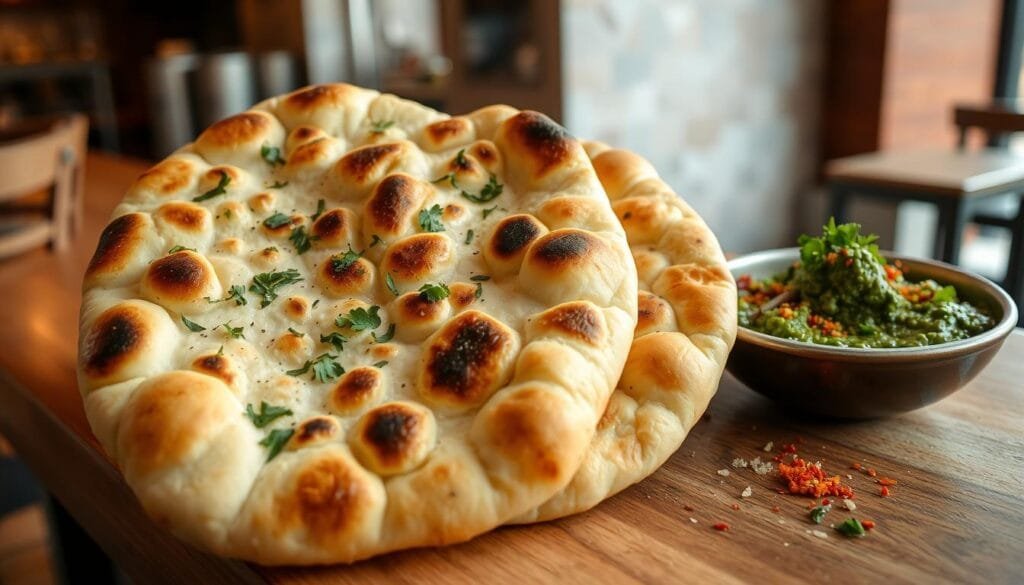
Essential Ingredients for Homemade Vegan Naan
Making vegan naan bread at home is easy. You’ll need all-purpose flour, instant yeast, sugar, salt, baking powder, and coconut cream or plant-based yogurt. These ingredients help you make a fluffy naan that’s just like the traditional one.
Kitchen Tools You’ll Need
To start, grab a large mixing bowl and a wooden spoon. You’ll also need a heavy-bottomed pan or cast iron skillet for cooking. These tools will help you make homemade vegan naan quickly.
Ingredient Substitutions and Options
This recipe is flexible. For a gluten-free version, use a gluten-free flour blend instead of all-purpose flour. If coconut cream is hard to find, try plant-based yogurts or a mix of non-dairy milk and apple cider vinegar. This way, you can make vegan naan that fits your diet and taste.
With these vegan baking ingredients and kitchen tools, you’re ready to make delicious vegan naan at home. Check out this recipe for more details: vegan naan bread.
Mastering the Perfect Naan Dough
Making the perfect bread dough for homemade naan is about finding the right mix. You need to blend dry ingredients like bread flour, salt, and yeast with warm water and yogurt. This mix creates a dough that’s moist but not sticky, giving naan its soft, fluffy texture.
The kneading process is key. Spend 4-6 minutes kneading the dough until it’s smooth and elastic. This step builds the gluten, which makes naan chewy. After kneading, let the dough rise in a warm spot for at least 90 minutes, or up to 4 hours. This time lets the yeast add flavor and air pockets, making the naan light and airy.
“The perfect naan dough is a delicate balance of hydration and structure. Knead it well, and let it rise to unlock the true flavor of this beloved Indian flatbread.”
With the right bread dough techniques and kneading methods, you’ll soon be a pro at making naan. Remember, the dough is the base. Treat it well, and your naan will be amazing.
The Science Behind Yeast Activation
Knowing how yeast works is key to making great homemade naan bread. Yeast is a living thing that makes dough rise by turning sugars into carbon dioxide. This process makes naan soft and light.
Temperature Control Tips
The best water temperature for yeast is between 100-110°F (37.8-43.3°C). This temperature lets yeast grow well without dying from too much heat. When it’s just right, the yeast mixture will start to foam and froth in about 15 minutes.
Troubleshooting Yeast Issues
If your yeast isn’t working, there could be a few reasons. First, check if your yeast is expired. Old yeast can’t ferment properly. Also, make sure the area is warm and not drafty. Yeast needs a steady, cozy temperature to activate.
Other things like cold or hot water, or adding too much salt or rich ingredients, can also stop yeast from working. These can make your dough not rise.
By understanding yeast activation and the factors that affect it, you can make naan bread that rises perfectly every time.
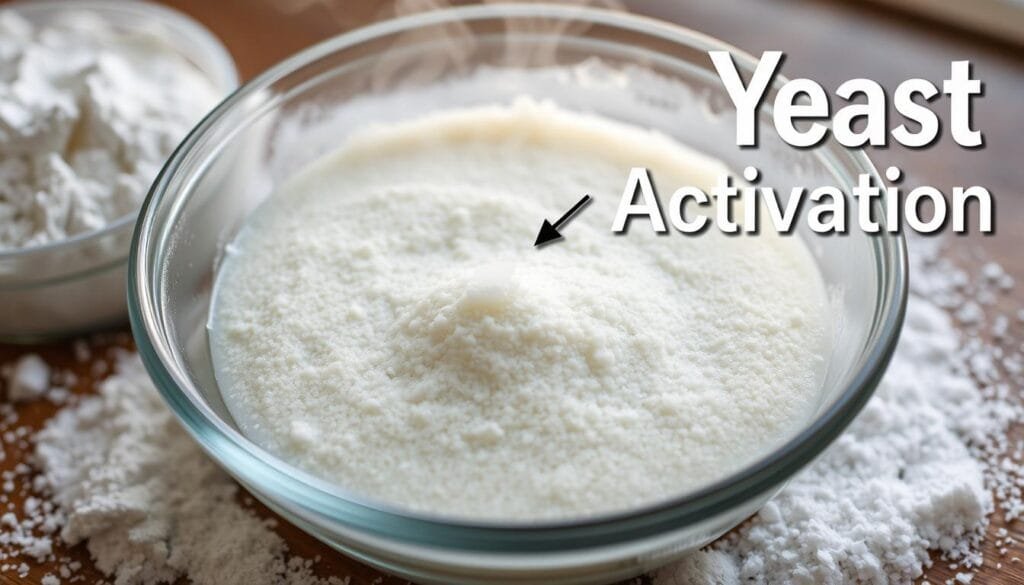
| Enzyme | Function |
|---|---|
| Amylases | Break down starches into sugars for yeast to feed on, preventing them from attacking gluten |
| Proteases | Facilitate the breakdown of proteins, enriching dough flexibility and stretch |
Enzymes are important in baking. They help speed up chemical reactions and improve bread quality. Knowing about enzyme activity helps bakers fine-tune their bread’s flavor.
Kneading and Dough Development Techniques
Learning to make bread starts with kneading the dough right. This step is key to making the dough soft and elastic. As a vegan baker, I’ve found kneading for 5-10 minutes by hand is essential for perfect gluten development.
When kneading naan dough, don’t add extra flour, even if it’s sticky. Instead, lightly oil your hands. This keeps the dough hydrated, making the naan soft and pillowy.
- Knead the dough for 5-10 minutes until it becomes smooth, pliable, and elastic.
- Avoid adding extra flour, as this can lead to a dense, dry texture. Instead, lightly oil your hands as needed.
- The final dough should be well-hydrated but not sticky, with a smooth and uniform appearance.
Proper kneading is the base for making tasty and beautiful naan. By mastering this, you’ll make homemade naan that’s as good as traditional Indian flatbreads.
| Ingredient | Quantity |
|---|---|
| All-purpose Flour | 3 cups (420g) |
| Sugar | 1 tablespoon (16g) |
| Instant Yeast | 1 1/2 teaspoons (3g) |
| Salt | 1 1/2 teaspoons (6g) |
| Vegan Yogurt | 1 cup (225g) |
| Warm Water | 1/2 cup (120g) |
| Melted Vegan Butter/Coconut Oil | 3 tablespoons (42g) |
“Kneading is the foundation of great bread. It develops the gluten structure, resulting in a soft, pliable dough that bakes up light and airy.”
The Art of Shaping Naan Bread
Making perfect naan bread is more than just the dough. It’s also about how you shape it. You can shape naan in two main ways: hand-pulling or rolling. Each method gives a different look and feel, letting you make your naan just how you like it.
Hand-Pulling vs. Rolling Methods
Hand-pulling means stretching the dough with your fingers to get a rustic shape. This makes a soft, pillowy naan that looks like it was made by hand. On the other hand, rolling the dough makes it even and uniform, giving your naan a professional look.
Creating Traditional Tear-Drop Shapes
To make naan in the traditional tear-drop shape, pull one end of the dough more than the other. Each naan should be about 1/4 inch thick and 8 inches long by 5 inches wide at its widest. Sprinkling chopped cilantro on the dough before cooking adds flavor and looks great.
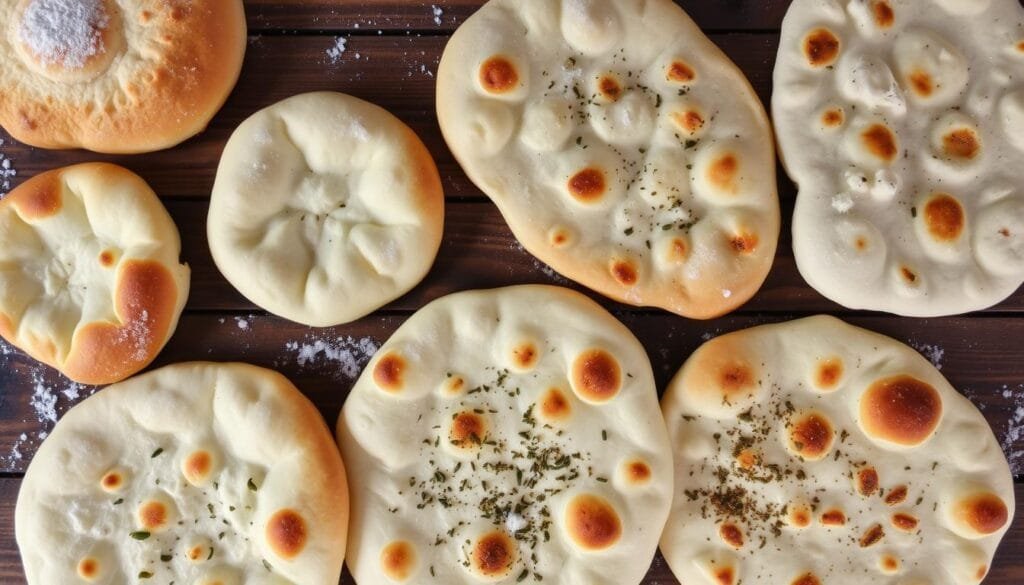
Getting good at shaping naan takes practice, but it’s worth it. Whether you like the rustic look of hand-pulled naan or the neatness of rolled naan, the key is to try different techniques. Find what works best for you and your cooking.
Cooking Methods and Temperature Control
Naan, the beloved Indian flatbread, can be cooked in two main ways: on the stovetop or in the oven. Each method needs careful temperature control to get the right texture and taste.
Stovetop Cooking
To cook on the stovetop, use a hot, non-stick pan or cast iron skillet over medium-high heat. Cook each side of the stovetop naan for about 45 to 60 seconds. Flip it several times until charred spots show up. This quick cooking makes the naan puffy and charred, just like authentic naan.
Oven-Baked Naan
You can also bake the oven-baked flatbread in the oven. First, preheat a pizza stone or baking sheet to 450°F (232°C). Then, place the naan on it and cook for 2 to 3 minutes on each side. Watch closely to avoid burning.
Getting the right cooking techniques and temperature is key for perfect naan. Too hot can burn the outside and leave the inside raw. Too cold makes it dense and doughy. Try different heat settings and cooking times to get light, fluffy naan every time.
| Cooking Method | Temperature | Cooking Time |
|---|---|---|
| Stovetop | Medium-high heat | 45-60 seconds per side |
| Oven | 450°F (232°C) | 2-3 minutes per side |
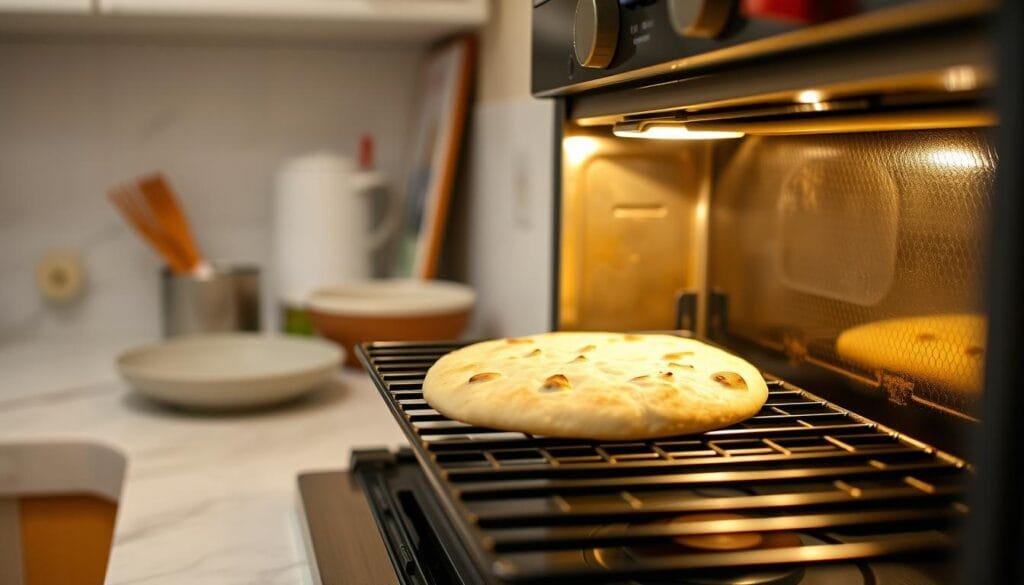
“The secret to perfect naan lies in the right balance of heat and timing. With a little practice, you’ll be turning out fluffy, charred naan that will transport you straight to the heart of India.”
Flavoring Options and Toppings
Vegan naan bread is a blank canvas for many flavors and toppings. Garlic naan is a favorite, made by pressing garlic into the dough or brushing with garlic butter. You can also add fresh herbs like cilantro or parsley for extra flavor.
For a sweet twist, try adding sugar and spices like cinnamon. On the other hand, vegan cheese, nutritional yeast, or spice blends can be mixed into the dough or used as toppings. The choices are endless for making your naan unique.
Garlic and Herb Variations
- Garlic Naan: Press minced garlic into the dough before cooking or brush with garlic-infused vegan butter after baking.
- Herb Naan: Mix fresh herbs like cilantro or parsley into the dough or sprinkle on top of the baked naan.
Sweet and Savory Options
- Sweet Naan: Incorporate sugar and spices like cinnamon into the dough for a delightful sweet flavor.
- Savory Naan: Top with vegan cheese, nutritional yeast, or spice blends for a savory twist.
| Ingredient | Percentage |
|---|---|
| Dairy-free milk | 33% |
| Plain dairy-free yogurt | 16% |
| Active yeast | 1% |
| Sugar | 2% |
| Olive oil | 7% |
| Bread flour | 41% |
| Salt | 0.5% |
“The possibilities are endless when it comes to customizing your naan flavors and bread toppings.”
Serving Suggestions and Pairings
Naan, the beloved Indian flatbread, is a versatile companion. It can elevate a variety of dishes. Whether you’re craving a comforting vegan curry, a flavorful Indian meal accompaniment, or a simple snack, naan bread is the perfect choice.
Serve warm naan with your favorite vegan curry dishes, such as Chana Masala or Vegetable Korma. This classic pairing never disappoints. Naan also makes an excellent base for flatbread serving ideas, like wrapping it around falafel or a creamy curry tofu salad.
- Enjoy naan as a versatile accompaniment to a wide range of Indian meal accompaniments, from lentil-based dals to fragrant rice dishes.
- For a quick and easy snack, brush warm naan with vegan butter. Sprinkle it with herbs or minced garlic for a flavorful treat.
- Naan can also serve as a delicious canvas for homemade vegan curry pairings, such as personal-sized vegan pizzas or open-faced sandwiches with your favorite toppings.
Naan’s soft, pillowy texture and neutral flavor profile make it an ideal companion for a variety of cuisines. Explore the endless possibilities of this versatile flatbread. Discover new ways to incorporate it into your favorite Indian meal accompaniments and vegan curry pairings.
| Dish | Pairing Suggestions |
|---|---|
| Chana Masala | Warm naan, basmati rice |
| Palak Paneer | Whole wheat naan, raita |
| Butter Chicken | Garlic naan, cucumber salad |
| Vegetable Korma | Naan, steamed rice |
“Naan is the perfect canvas for exploring the rich and diverse flavors of Indian cuisine.”
Storage Tips and Reheating Methods
Enjoying freshly baked naan is the best way to enjoy its flavors and soft texture. But, sometimes we have leftovers or need to prepare naan ahead of time. Luckily, there are ways to keep your homemade naan bread fresh.
To store naan for a short time, keep it in an airtight container at room temperature for up to 3 days. For longer storage, freeze it. Place cooled naan in freezer-safe bags or a container and freeze for up to 2 months. Frozen naan stays fresh and can be reheated as needed.
There are several ways to reheat naan. For the microwave, warm it in 15-second intervals on medium-high until it’s hot. In the oven, reheat at 350°F (175°C) for 3-5 minutes. You can also warm it on the stovetop for 30 seconds per side over medium heat.
If you have an air fryer, crisp up the naan at 350°F (175°C) for 3-5 minutes. No matter how you reheat it, brush the naan with water or vegan butter to make it soft and moist again.
